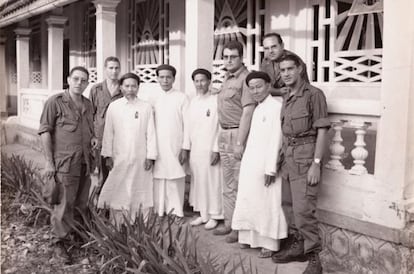Spain's secret support for US in Vietnam
Documentary details Franco's discreet involvement in anti-communist war

A new documentary first shown late last month on Spain's Historia cable channel reveals the secret involvement of Spanish army medical corps staff on the side of the United States during the Vietnam War in the mid-1960s.
In 1965, after increasing the number of US troops in its fight to prop up the regime in South Vietnam against the communist forces led by Ho Chi Minh in North Vietnam, President Lyndon B. Johnson asked General Franco to contribute a military contingent to the war effort.
After lengthy debate between his ministers, Franco took the advice of General Agustín Muñoz Grandes, a senior member of his government, and the man who had commanded the Blue Division, the 45,000-strong force sent by Franco to support Hitler's invasion of Russia.
Muñoz Grandes had close contacts with the US military, and had negotiated agreements with Washington. He saw Spanish participation in the war as an opportunity to further strengthen ties with the United States. But Franco was even more cautious in committing himself to the US cause than he was about Hitler's, and finally decided to send a medical team of around 30 people, and under strict secrecy.
Franco didn't want to be seen backing the US' unilateral war"
"The expedition was a secret because Franco didn't want military ties with the United States, and much less wanted to be seen to be supporting Washington's unilateral war against Vietnam," says General Antonio Velázquez Rivera, then a 25-year-old lieutenant with the army medical corps. "Vietnam was the first war to be televised, and was soon being cursed around the globe," he adds.
The first group of medical soldiers, including four doctors, seven nurses and one officer in charge of military supplies, arrived in Vietnam in 1966 and worked at Truong Cong Dinh hospital in the Go Gong district, about 45 kilometers from the capital, Saigon. From 1966 to 1971 three other groups, totaling nearly 100 Spaniards, worked at the hospital.
To avoid being seen to be publicly supporting the United States, General Franco ordered the medics to keep their activities secret. The soldiers, who completed their mission in 1971, were told to remain silent. The secret of the Spanish intervention in Vietnam was discovered by journalist Alejandro Ramírez, who published a book about it in 2005, and which was the basis for the documentary film.
Captain Ramón Gutiérrez de Terán was among those who traveled to Vietnam. "We took a civilian flight, and were not wearing military fatigues. Nobody came to see us off. We knew where Vietnam was, more or less, but not where we were actually to be based." Like the others who volunteered, Gutiérrez de Terán says that he saw his mission as a humanitarian one, and that he wanted to travel, to see the war close up.
Nobody came to see us off. We knew where Vietnam was, more or less"
When the team arrived, its members were transferred to their hospital, which was close to the Ho Chi Minh trail, the supply route used by the communist forces. "It was then when we realized what we had gotten ourselves into: there was a constant coming and going of helicopters and a terrible smell of napalm everywhere," says Gutiérrez de Terán.
Máximo Cajal, a Spanish diplomat then based in Thailand, met some of the volunteers. "The group I met had been based in the relative safety of the Western Sahara, and they suddenly found themselves in the middle of a war in the Mekong Delta; it was quite a shock for them," he says.
"On the two occasions when I had to see the medical team in Go-Gong I had to travel by helicopter because the roads were all controlled by the Vietcong," the diplomat recalls.
Velázquez says that the hospital they worked in was in poor shape. "It was an old colonial building, falling apart, and the hygiene was terrible. There were 150 beds, and at times, up to 400 injured and wounded. We had no medical supplies; we had to scrounge them from either the Americans or the guerrillas," he says.
The hospital did not attend solely to military personnel, or civilians caught up in the fighting; the team also performed simple operations on children with cleft palates, or pregnant women with typhoid fever.
"The local people were very supportive of us, and recognized our help by dedicating a bridge to us," says Velázquez.
Tu suscripción se está usando en otro dispositivo
¿Quieres añadir otro usuario a tu suscripción?
Si continúas leyendo en este dispositivo, no se podrá leer en el otro.
FlechaTu suscripción se está usando en otro dispositivo y solo puedes acceder a EL PAÍS desde un dispositivo a la vez.
Si quieres compartir tu cuenta, cambia tu suscripción a la modalidad Premium, así podrás añadir otro usuario. Cada uno accederá con su propia cuenta de email, lo que os permitirá personalizar vuestra experiencia en EL PAÍS.
¿Tienes una suscripción de empresa? Accede aquí para contratar más cuentas.
En el caso de no saber quién está usando tu cuenta, te recomendamos cambiar tu contraseña aquí.
Si decides continuar compartiendo tu cuenta, este mensaje se mostrará en tu dispositivo y en el de la otra persona que está usando tu cuenta de forma indefinida, afectando a tu experiencia de lectura. Puedes consultar aquí los términos y condiciones de la suscripción digital.








































